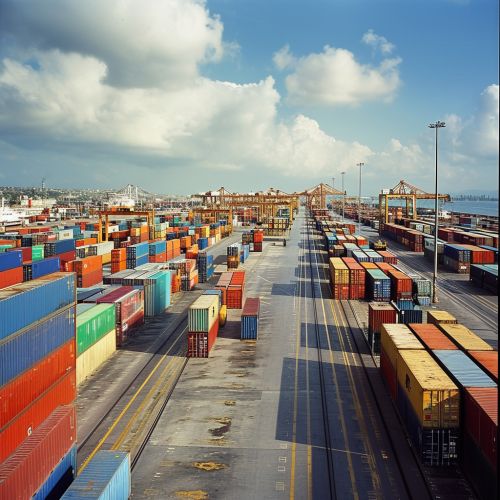Trade Channels
Overview
Trade channels, also known as distribution channels, are the pathways through which goods and services move from the producer or manufacturer to the end consumer. They are an essential component of the supply chain management process, facilitating the efficient and effective distribution of products to the marketplace.


Types of Trade Channels
There are several types of trade channels, each with its own characteristics and benefits. These include direct and indirect channels, intensive, selective and exclusive distribution, and dual or multi-channel distribution.
Direct Channels
In a direct channel, the producer sells goods or services directly to the consumer. This can be done through a physical store owned by the producer, online sales, or direct mail. Direct channels allow for greater control over pricing, promotion, and customer service.
Indirect Channels
Indirect channels involve the use of intermediaries, such as wholesalers, distributors, and retailers. These intermediaries buy products from the producer and sell them to the end consumer. Indirect channels can help reach a larger market and reduce the burden of distribution on the producer.
Intensive Distribution
Intensive distribution involves selling a product through all available outlets in a market. This strategy is often used for convenience products, such as soft drinks or chewing gum, which consumers expect to find in a variety of locations.
Selective Distribution
Selective distribution involves selling a product through a limited number of outlets in a market. This strategy is often used for specialty products, such as high-end electronics or luxury goods, which benefit from being associated with select, high-quality retailers.
Exclusive Distribution
Exclusive distribution involves selling a product through a single outlet in a specific geographic area. This strategy is often used for highly exclusive or luxury goods, and allows for a high degree of control over the product's presentation and selling environment.
Dual or Multi-Channel Distribution
Dual or multi-channel distribution involves using more than one type of trade channel to reach the consumer. This strategy allows for greater market coverage and can cater to different consumer preferences for shopping and purchasing.
Factors Influencing Choice of Trade Channel
Several factors influence the choice of trade channel, including product characteristics, market characteristics, company objectives, and competitive factors.
Product Characteristics
The nature of the product, including its complexity, price, and perishability, can influence the choice of trade channel. For example, complex or high-value products may benefit from a direct channel, where the producer can provide detailed information and customer service.
Market Characteristics
The size, geographic dispersion, and buying habits of the target market can also influence the choice of trade channel. For example, a large, widely dispersed market may be best served by an indirect channel with a wide distribution network.
Company Objectives
The company's objectives, such as its desired level of control over the product, its resources, and its commitment to customer service, can also influence the choice of trade channel. For example, a company that values direct interaction with customers may prefer a direct channel.
Competitive Factors
The company's competitive environment, including the distribution strategies of competitors, can also influence the choice of trade channel. For example, if all competitors are using indirect channels, a company may choose to differentiate itself by using a direct channel.
Role of Trade Channels in Marketing
Trade channels play a crucial role in marketing. They are responsible for the placement of the product, one of the four Ps of the marketing mix (product, price, place, promotion). They ensure that products are available in the right place at the right time, and in the condition and quantity that consumers demand.
Trade channels also play a role in communication, delivering information about products and promotions to consumers, and feedback from consumers to producers. They can also provide value-added services, such as after-sales service and support, which can enhance the consumer's experience of the product.
Challenges in Managing Trade Channels
Managing trade channels can present several challenges. These include channel conflict, control issues, and the complexity of managing multiple channels.
Channel Conflict
Channel conflict can occur when different members of the same trade channel compete with each other for the same customers. This can lead to reduced sales and profitability for some or all channel members.
Control Issues
Control issues can arise when the producer has limited control over the intermediaries in the trade channel. This can lead to problems with product presentation, pricing, and customer service.
Complexity of Managing Multiple Channels
Managing multiple trade channels can be complex and resource-intensive. It requires careful coordination to ensure that all channels are working together effectively and not undermining each other.
Future Trends in Trade Channels
Trade channels are evolving in response to changes in technology, consumer behavior, and the business environment. Trends include the growth of e-commerce, the rise of direct-to-consumer channels, and the increasing importance of supply chain sustainability.
Growth of E-Commerce
The growth of e-commerce is changing the landscape of trade channels. More and more consumers are buying products online, leading to the growth of direct-to-consumer channels and the decline of some traditional retail channels.
Rise of Direct-to-Consumer Channels
The rise of direct-to-consumer channels is another important trend. These channels allow producers to sell directly to consumers, bypassing traditional intermediaries. This can allow for greater control over the product and the customer experience, and can also provide valuable data on consumer behavior.
Increasing Importance of Supply Chain Sustainability
The increasing importance of supply chain sustainability is also influencing trade channels. Consumers are increasingly concerned about the environmental and social impact of their purchases, and are demanding greater transparency and responsibility from producers and retailers. This is leading to changes in the way products are sourced, produced, and distributed.
